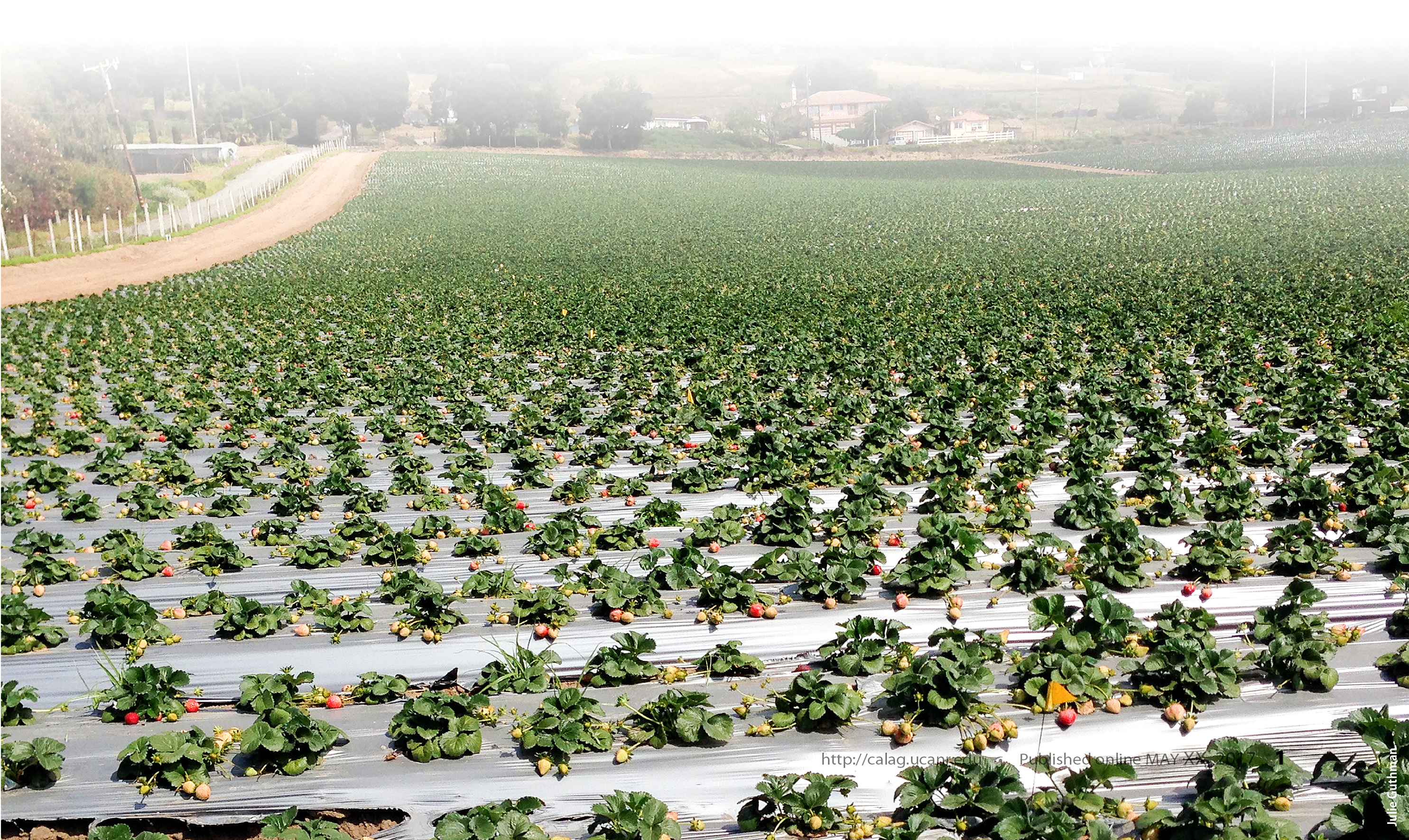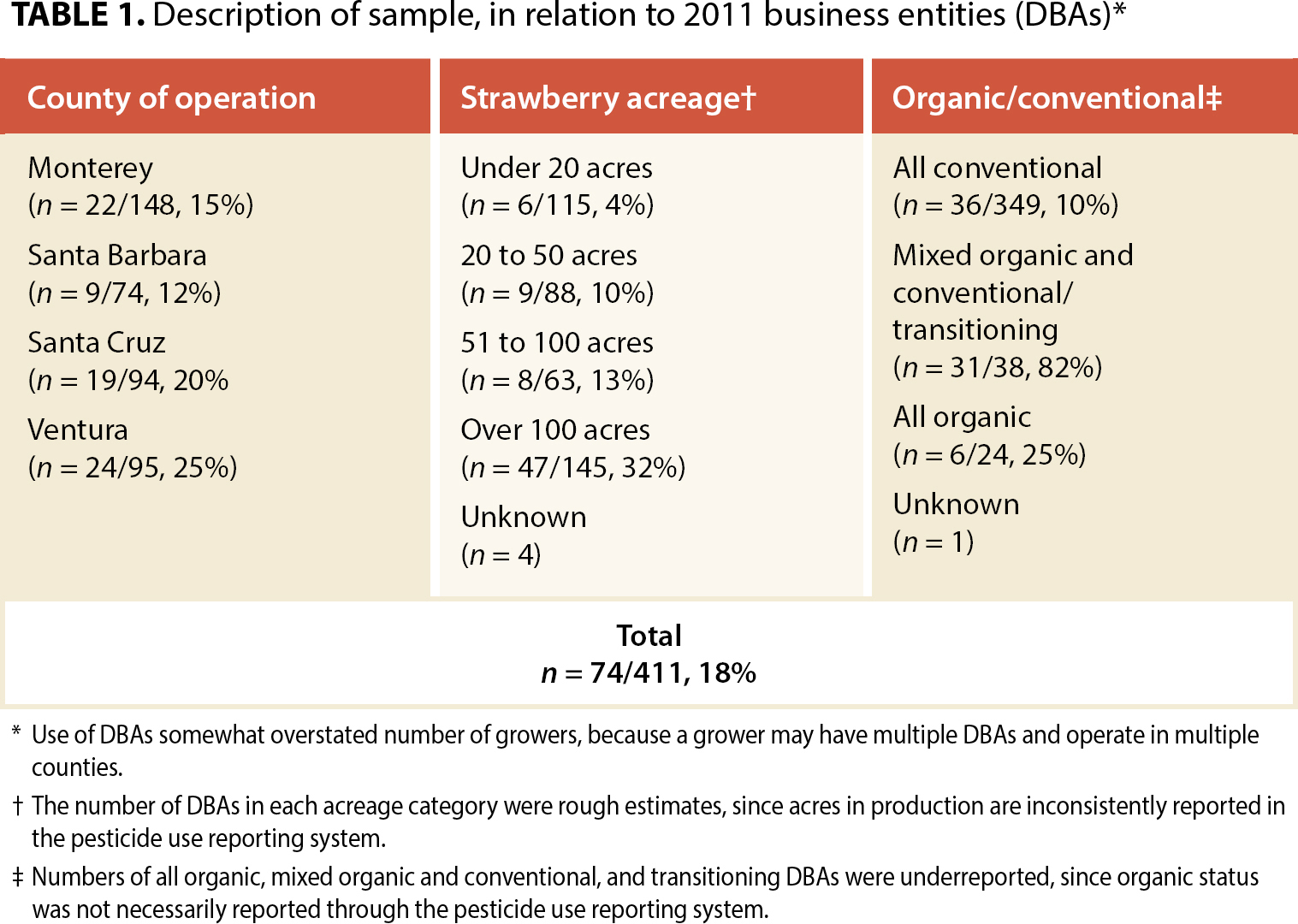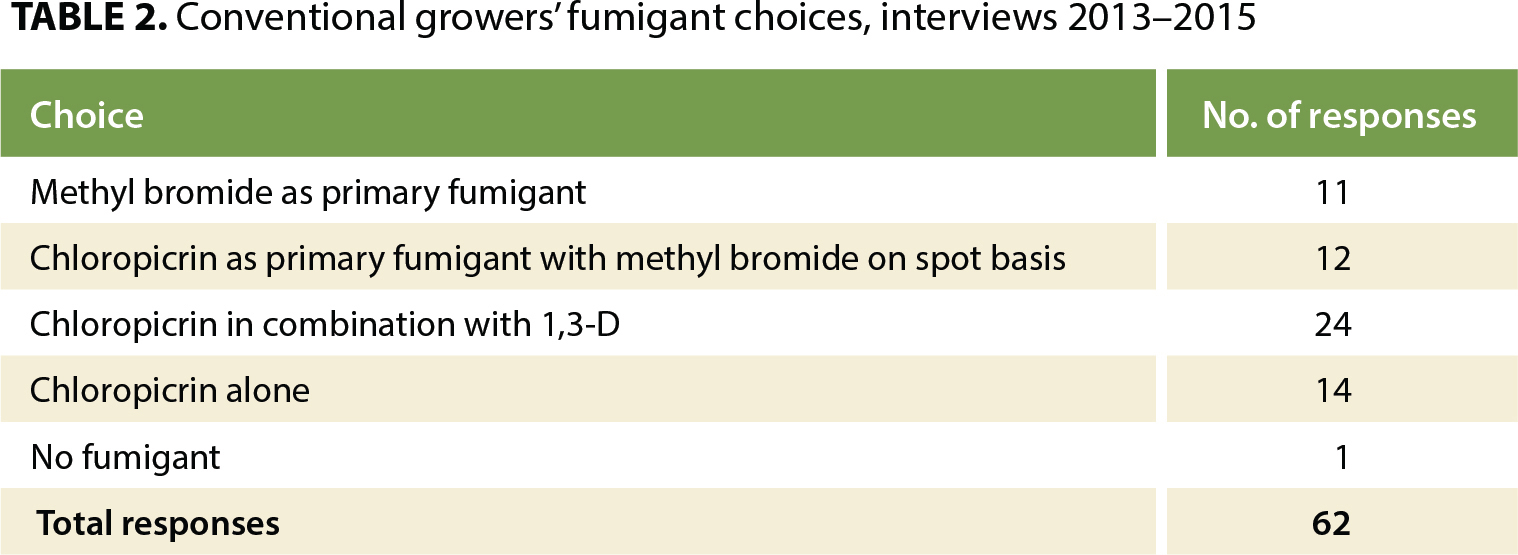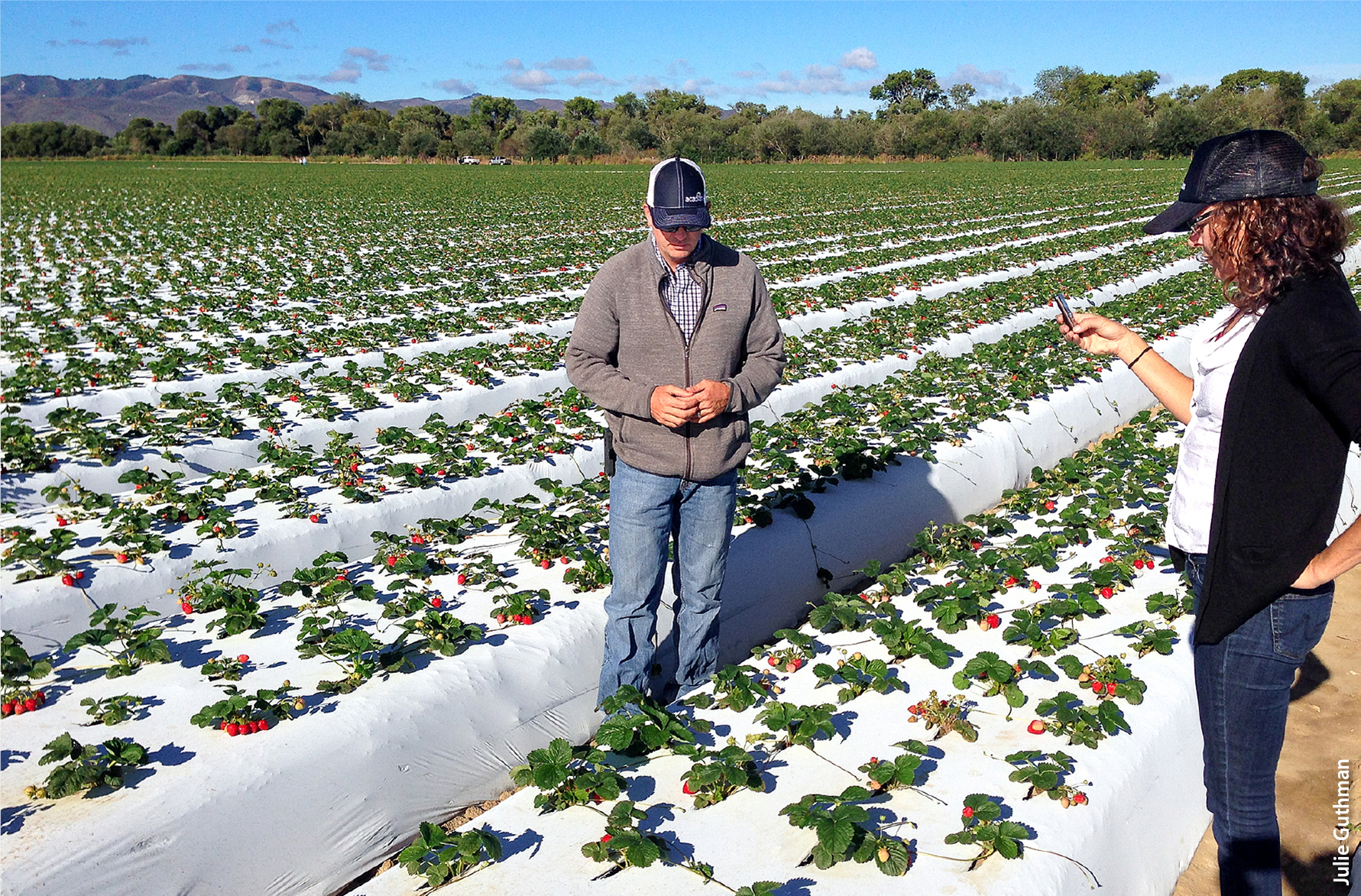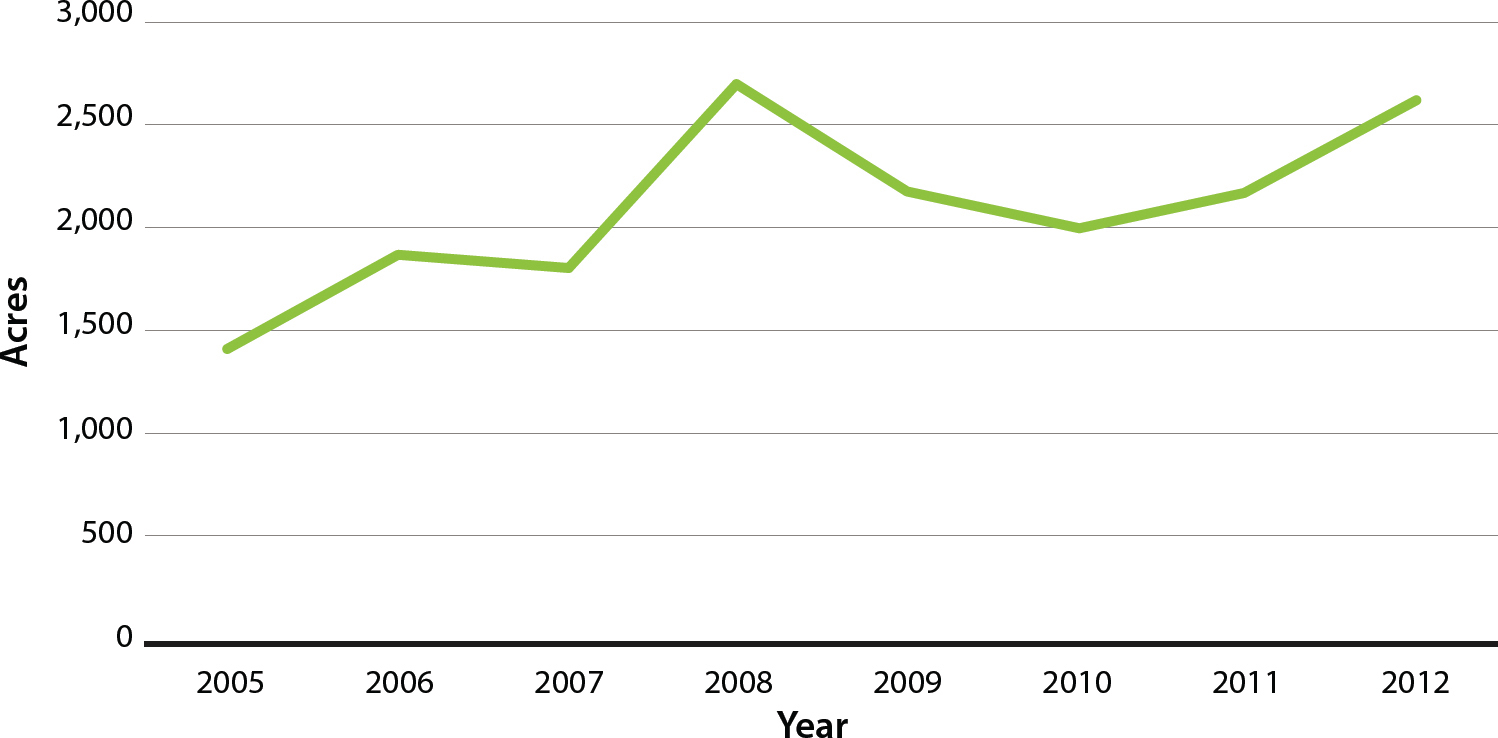All Issues
Land access and costs may drive strawberry growers' increased use of fumigation
Publication Information
California Agriculture 71(3):184-191. https://doi.org/10.3733/ca.2017a0017
Published online May 15, 2017
NALT Keywords
Abstract
2016 marked the year of the final phaseout of methyl bromide for use in strawberry production. During the long phaseout period, one replacement fumigant met so much public opposition it was taken off the market, while restrictions on use of other fumigants increased. As part of a larger study on the challenges facing the strawberry industry, I tracked fumigant use through California's pesticide use reporting system from 2004 to 2013. During the last few years before the phaseout, I interviewed 74 growers in the four main strawberry production regions about how they were now managing soilborne pests. As a general trend, growers had increased their use of chloropicrin and switched from broadcast fumigation to bed fumigation, and many were experimenting with organics. At the same time, significant percentages of growers were reluctant to change fumigation regimes or adopt nonchemical options of pathogen control. Some were unable to adopt less chemical-intensive methods because of land access conditions and land costs. Given these land-related obstacles, policymakers ought to consider strategies that will incentivize transitions to nonchemical alternatives and mitigate the financial risks.
Full text
Last year, 2016, marked the final phaseout of methyl bromide for use in strawberry production. By year's end, many of the pessimistic predictions about the California strawberry industry's future had not come to pass. Consumer costs had not increased to cover expected higher production costs (e.g., Carpenter et al. 2000; Norman 2005), nor had production substantially moved to Mexico, which, per Montreal Protocol rules, initially was granted a longer phaseout period than the United States (Carter et al. 2005; Goodhue et al. 2005).
Indeed, both the overall production of strawberries and the rates of productivity continued to increase in California throughout the phaseout period, and prices for berries declined rather than rose (Mayfield and Norman 2012). Even in the last years of the phaseout, acres planted in strawberries held relatively steady — 37,732 acres were planted in 2012 and 36,039 were planted in 2016, with little variation in between those years (California Strawberry Commission 2016).
As methyl bromide use declined during the phaseout period, most of the California strawberry growers surveyed increased their use of alternative fumigants such as chloropicrin.
During the final years of the phaseout, I completed a study of the strawberry industry, one of the goals of which was to learn how growers were managing soilborne pests and to see what, if any, changes they had made in recent years in light of regulatory pressures to curtail fumigant use. Through interviews, I learned of factors that were either encouraging or impeding transitions to nonchemical methods of soil disinfestation. Results of this study shed light on why most growers have not transitioned to nonchemical pest control strategies despite the long phaseout period for methyl bromide.
Fumigation options, regulations
For about 50 years, California's strawberry industry has relied on chemical fumigants to disinfest soil of pathogens, as well as to control weeds and nematodes. The most favored fumigant has been methyl bromide, a broad-spectrum fumigant, supplemented with chloropicrin. With its unpleasant smell and tendency to cause eyes to tear, chloropicrin served as a warning agent. Additionally, it created a synergistic effect with methyl bromide.
In 1991, the Montreal Protocol on Substances that Deplete the Ozone Layer mandated the phaseout of methyl bromide. As a signatory to the convention, the United States agreed to stop producing and importing methyl bromide by 2005. However, as that deadline drew near, U.S. negotiators, under pressure from the strawberry industry, successfully lobbied for provisions that would grant critical use exemptions (CUEs) for producers who claimed that no viable alternative was available. CUEs thereby allowed for the continued use of methyl bromide in strawberry production well beyond the international deadline of 2005 (Gareau 2008; Mayfield and Norman 2012). Nonetheless, in accordance with the Protocol, approved amounts of methyl bromide for use by strawberry growers declined precipitously during the years of this study in anticipation of the total ban at the end of last year. Nursery stock producers received a separate “quarantine” exemption to prevent the introduction of certain pests into new areas.
Over the course of the phaseout, many in the industry hoped for a replacement chemical. The most promising replacement, methyl iodide, met considerable public opposition, however, and was withdrawn from the market soon after California approved the chemical for use (Guthman 2016). Meanwhile, chloropicrin began to see tighter use restrictions following its 2010 designation as a toxic air contaminant by the U.S. Environmental Protection Agency (EPA) and re-review by California's Department of Pesticide Regulation (DPR). In 2015, DPR mandated enhanced mitigation measures for chloropicrin applications that were modified in 2016. These included wider buffer zones between applications and nearby buildings, incentives in the form of reduced buffer zone requirements with the use of totally impermeable film (TIF) to cover fumigations, and increased monitoring requirements. These measures are detailed in Goodhue et al. (2016). 1,3-dichloropropene (Telone), used by some strawberry growers, is already limited by township caps. During the phaseout period for methyl bromide, DPR began undertaking further risk assessment to determine whether the caps are sufficient to protect public health (DPR 2014).
A buffer zone around a home in Monterey County. To reduce human exposure to fumigants, California regulations require growers to maintain unfumigated buffer zones between fumigant applications and nearby buildings. One consequence, according to the strawberry growers surveyed, has been a shift, where feasible, to more remote locations.
Other substitute chemicals, used less frequently in strawberry fumigation, have also seen more scrutiny. In 2010, DPR released new permit conditions for metam sodium, metam potassium and dazomet, primarily increasing buffer zones and worker protections. This is likely not the end of the restrictions. In 2013, DPR published an action plan that argued for curtailing and eventually phasing out all fumigants to protect the health of farmworkers, bystanders and nearby communities (DPR 2013). Although the plan's primary purpose was to generate innovation and dissemination of alternative methods of soil management, it signaled encouragement to reduce fumigant use.
Pesticide use decision-making
A wealth of studies have examined the factors, variables and considerations that shape grower decisions about pesticide use. A significant set of these focus on how differing perceptions of pest virulence, treatment efficacy, and the health and environmental risks of chemicals play a role in pesticide use decisions (Hashemi and Damalas 2010; Heong et al. 2002; Khan and Damalas 2015; Parveen et al. 2003; Penrose et al. 1996). Some studies note that the perceived potential for economic loss from pesticide reduction often overrides other concerns (Damalas and Koutroubas 2014; Kishi 2002; Tucker and Napier 2001).
Another set of studies focus on the personal and farm characteristics that are associated with grower interest in pesticide reduction. Several studies have found, for example, that growers who adopt sustainable agriculture techniques tend to be younger and/or more educated (Comer et al. 1999; Damalas and Koutroubas 2014; Lasley et al. 1990; Lighthall 1995). Others have emphasized the importance of growers' access to economic resources, and technical support and information (Chaves and Riley 2001; Khan and Damalas 2015; McNamara et al. 1991; Mumford 1981; Robinson et al. 2007; Thiers 1997; Thomas et al. 1990).
Some studies have considered obstacles to pesticide reduction, such as labor costs and availability (Pfeffer 1992) and the pressure exerted by buyers and extension agents to use pesticides (Barraza et al. 2011; Bellamy 2011; Galt 2014; Harrison 2011). A few have suggested that a constellation of factors influence pesticide use decisions, that they cannot be distilled to one or two factors (Beus and Dunlap 1994; Carolan 2005; Duram 2000; Williamson et al. 2003).
Research has also examined rationales for transitioning to organic production. Many of these studies emphasize growers' beliefs and values (Cranfield et al. 2010; Darnhofer et al. 2005; Devitt 2006; Fairweather 1999; Kings and Ilbery 2010). Others give greater emphasis to the role of comparative production costs and marketing opportunities (or obstacles) in growers' decisions to convert acreage to organics (Bartulovi? and Kozorog 2014; Campbell 1996; Duram 1997; Fairweather 1999; Guthman 2014; Padel 2001; Smit et al. 2009).
The vast majority of the pesticide use research presumes that growers are in a position to reduce their use of pesticides voluntarily. Studies that examine regulation-driven changes in pesticide use are hard to come by. Also, the role of land (e.g., availability, cost, conditions of access) in pesticide decisions has received little attention, other than a few studies that examine the constraints that tenant farmers encounter for pesticide reduction due to landlord skepticism (Carolan 2005; Constance et al. 1996) or research showing how land values have affected organic conversions (Guthman 2014; Risgaard et al. 2007). My study addressed the nonvoluntary reduction of pesticide use by assessing grower decision-making in a regulation-forcing context and by prompting growers about land considerations.
Fumigant use data, interviews
As part of a large research project covering a range of issues related to the challenges facing the strawberry industry, I tracked fumigant use in nine counties through California's pesticide reporting program from 2004 to 2013. The nine counties contained the primary areas of fumigant applications for strawberries, including the nursery stock production areas in the far north of the state.
From 2013 to 2015, I also interviewed strawberry growers in the four counties that contain the main centers of strawberry fruit production: Watsonville (Santa Cruz County), Salinas (Monterey County), Santa Maria (Santa Barbara County) and Oxnard (Ventura County). The interviews covered topics beyond the topics of fumigant use and alternatives reported here. They were semistructured, based on themes determined in advance but designed to allow the interviewer to explore issues raised by the interviewee, including unexpected themes (David and Sutton 2004). For the purposes of reporting on fumigation use and alternatives, interviews consistently included questions on farm data, fumigation regimes, experience with organics and experimentation with nonchemical alternatives. Sample questions on these themes can be found in the sidebar below.
Sample interview questions
-
Farm data
-
How many acres do you grow? Where?
-
What do you grow besides strawberries? In rotation with strawberries or on separate plots?
-
How many acres in strawberries?
-
How many years have you been farming? Farming strawberries?
-
Do you lease or own your land? Or both?
-
How many acres in organic or transitioning? Which parcels?
-
-
Practices
-
What is the primary way you currently deal with pathogens?
-
What is your fumigation regime (what chemicals, what methods)?
-
Why that chemical, those methods?
-
Do you use different regimes for different parcels? Why?
-
How has your fumigation program changed over the past 10 years?
-
What mitigation measures do you use?
-
Have you experimented with alternatives? Which ones? What were the results? Will you continue?
-
-
Influences
-
How do you decide which fumigants to use, when and in what quantities?
-
Who do you look to for advice?
-
What, if any, restrictions/advice does your buyer give?
-
How do your lease arrangements/land ownership influence your fumigation decisions?
-
How about mitigation measures?
-
How does past history of pathogens on parcels influence fumigation decisions?
-
Have you tried organics? Why or why not?
-
On which parcels have you tried organic production? Why those?
-
What other factors have influenced your decision-making (possible prompts: methyl bromide phaseout; increasing regulation/restrictions in general; pesticide activism/shifting political environment; toxicity; cost)?
-
To identify, characterize and locate growers in the four counties in which I intended to conduct interviews, I obtained pesticide use data from each of those counties from 2011, data that the state mandates counties collect and make public. Even though the California Strawberry Commission's website in 2011 claimed there were about 400 strawberry growers in the state of California, during that year there were 443 pesticide use permits for strawberry fumigation in those four counties alone, representing 411 business entities (which I refer to here as “Doing Business As” entities, or DBAs). During the interviews, I learned that many growers held multiple permits under different entities and across counties, which explained the inflated numbers.
Given the data available (not all counties provided contact information and not all contact information was correct), the difficulty of reaching many potential research subjects and the reticence of many to be interviewed about pesticide use, I opted for a convenience sample. I interviewed every grower who was reachable, willing to schedule an interview and then showed up for it (n = 74). The sample turned out to be broadly representative of the sector, although large growers made up a higher percentage of the sample since they tend to stay in business longer and have more reliable contact information. This oversampling of large growers was especially the case for Santa Barbara County, which did not provide contact information, forcing me to rely on publicly available contact information.
Growers with both organic and conventional systems and transitioning-to-organic growers appeared oversampled as well, but this was a function of a noticeable increase in organic growers since 2011, detailed below. I included only a few organic growers farming in diversified systems, instead choosing to focus on those for whom strawberries were the primary crop. Indeed, many growers with diversified systems were not included in the pesticide use data at all, which therefore understated the population of organic growers. Table 1 describes the sample across three dimensions compared with the number of DBAs in those four counties; the notes contain important caveats on the population data.
To arrange interviews, I or one of two research associates contacted growers with cold calls. The interviews took place at growers' homes and offices and occasionally by phone at the time of contact. With interviewee permission, most interviews were audio-recorded; otherwise interviewers took hand notes. In accordance with a human subjects protocol approved by the UC Santa Cruz Institutional Review Board, interviewees were promised protection of confidential information and anonymity in reporting results.
Following the interviews, research assistants transcribed the interviews and sorted the data into a standardized Word template along predetermined themes (e.g., fumigation practices, fumigation perspectives, fumigation information). These Word documents were uploaded into Nvivo (QSR International), a qualitative research software, which auto-coded each of the questions. I was then able to sort by theme and develop more refined codes that categorized grower responses within a broader theme. Doing the more refined operation myself minimized the potential for inconsistent coding. These refined categories were the basis of the responses reported in the study results. Not all growers answered or expanded on every question, which is why the total responses for a question could be less than the sample size.
More fumigant used during phaseout
As a general trend, growers did not significantly reduce their use of fumigants in the new regulatory context, but instead shifted to using chemicals that were still allowed, albeit with stricter mitigation measures. Figure 1 shows the pounds of fumigants applied to strawberry crops in the nine counties from 2004 to 2013. The decline of methyl bromide use during that period was far outweighed by the increase in use of alternative fumigants, chloropicrin in particular. One of the reasons that fumigant use increased, even as acres in production held steady, is that chloropicrin alone is not as effective as it is in combination with methyl bromide (Lloyd and Gordon 2016; Triky-Dotan et al. 2016).
Fig. 1. Pounds of fumigants applied for nine counties in the study, 2004 to 2013. Source: California pesticide use reporting program ( www.cdpr.ca.gov/docs/pur/purmain.htm ).
In keeping with this trend data, the interviews indicated that the vast majority of growers with conventional operations moved to using chloropicrin as the primary fumigant (table 2). In describing their rationales for moving away from methyl bromide, some said that there was no longer enough available, while others mentioned that it had become too expensive. These responses are two sides of the same coin: chloropicrin became much cheaper than methyl bromide because methyl bromide was in such short supply. Early adopters of chloropicrin alone moved to it to gain competitive advantage and to deflect public scrutiny. Only one grower, who runs a very small conventional operation, ceased fumigating.
An important question is how and why 23 of the 62 growers who responded to the question in interviews continued to use methyl bromide despite the cost and imminent phaseout. Some of them, those who used it on a spot basis, suggested they were eligible for CUEs due to particularly troublesome areas in their fields. Others used methyl bromide as their primary fumigant for as long as they could simply for its efficacy — and were willing to pay over twice the per-acre cost. Several of these growers admitted (and several other growers alleged) that being long-time, good customers of Tri-Cal, the fumigation company to which CUEs were allocated, enabled them to access the chemical.
The other reason that growers continued to fumigate with methyl bromide was because they rotated land with a vegetable or flower grower who demanded it. Such lease agreements, typical of the Salinas and Pajaro Valley regions in Monterey and Santa Cruz counties, are in many ways a win-win situation for vegetable and strawberry growers. Strawberry growers have access to ground for 14 or 15 months, allowing them to fumigate in the late summer, plant in late fall and start harvesting in late winter or early spring and continue harvesting through the fall, making for a lengthy harvest season and, hence, a profitable year. For their part, leafy greens growers can squeeze in two rotations of vegetables in the remaining 8 months. In doing so, they obtain the benefit of fumigation without having to report it. It is effectively an off-label use of fumigants for vegetable growers (Brian Leahy, DPR director, personal communication).
Research collaborator Sandy Brown interviews a strawberry grower in Santa Barbara County. Nearly one-third of growers surveyed continued using methyl bromide during the phaseout period, despite its high cost. This was due in part, these growers reported, to lease agreements with vegetable or flower growers who would rotate their crops with strawberries, thereby getting much of the benefit of a recently fumigated field without having to fumigate the fields themselves.
The increase in chemical use was surprising given that mitigation measures for several chemical fumigants are structured to encourage fumigation methods that reduce chemical use (Goodhue et al. 2016). For instance, growers may have smaller buffer zones if they fumigate in beds (through irrigation lines), which uses less fumigant than broadcasting (where the fumigant is injected into the soil of a leveled field by a fumigation rig and the planting beds are then constructed and covered with plastic to prevent the chemical from volatizing); growers who broadcast-fumigate are limited to fumigating in one 40-acre block at a time, but if they use totally impermeable film (TIF), which is required in some counties, they may have smaller buffer zones.
Most growers interviewed continued to use broadcast fumigation (table 3). Growers who used bed fumigation said that cost was a primary factor; many of them farmed in hilly areas, where broadcasting (also called flat fumigation) is more difficult. Growers who broadcast-fumigated cited efficacy as a key rationale. Their concerns have been corroborated by recent research, which attributes new pathogen outbreaks to bed fumigation. Apparently, pathogens remain in the rows between the beds and are able to recolonize (Goodhue et al. 2016; Koike and Gordon 2015). Besides efficacy, the primary reason growers broadcast-fumigated was that they rotated the land with leafy greens growers and, like many who use methyl bromide, were under a lease agreement in which the vegetable growers insisted they broadcast-fumigate — even when strawberry growers held the master lease. In other words, lease arrangements that were otherwise beneficial to strawberry growers were partially responsible for thwarting any reductions in their fumigant use.
Land issues came up in the interviews in another way. Growers who were in a position to lease new parcels chose parcels remote enough to not require buffer zones. This movement into more rural areas follows on research that showed that differing field conditions create highly uneven buffer zone sizes, giving growers without nearby buildings a distinct advantage (Goodhue et al. 2016). Indeed, the stricter buffer zone mitigations appear to be one of the reasons that strawberry production has shifted north from the Oxnard area to the relatively rural Santa Maria area that straddles Santa Barbara and San Luis Obispo counties. Growing strawberries in remote areas may curtail the public's exposure to pesticides, but it does not reduce fumigant use overall.
Increase in organic production
Another overarching trend that emerged with increased fumigation restrictions is the increase in organic strawberry production. Acres in organic production increased considerably after 2005, when the phaseout of methyl bromide was set to begin (fig. 2). The dip in 2009 was likely recession related, because overall organic production in California fell as demand for organic produce slowed following the financial crisis of 2007–2008 (Guthman 2014). Acres in organic strawberry production have picked up since, and organic strawberry sales show even more robust growth, from about $25.1 million in 2005 to $93.6 million in 2012 (Klonsky and Healy 2013; Klonsky and Richter 2011). More recent figures are not available, but interview data suggested this trend was unabated.
Fig. 2. Acres of organic strawberries in California. Acreage increased about 80% from 2006 to 2012, but still represented only 7% of all strawberry land in the state. Source: Klonsky and Healy (2013); Klonsky and Richter (2011).
Interview data did not entirely support the supposition that the transitions to organic were driven by increased regulation. Of the 34 mixed, transitioning or recently transitioned growers interviewed, 29 discussed their rationales for transitioning at least some of their fields to organic production (table 4). Of these, only eight stated that pesticide restriction was one of the factors guiding their decision; among the eight were growers who grew organic crops in the buffer zones of fumigated fields.
A few strictly conventional growers mentioned they would eventually transition to organic production if the restrictions continued. However, the majority of transitions already made were not motivated by either safety concerns or the potential loss of a favored technology, at least directly. In most cases, growers moved into organic production for market considerations. For some, that meant the higher prices and profits for organic berries — costs for organic production are fairly comparable on a per-acre basis to costs for conventional production, but, because of higher prices, profits for organic strawberries can be over $12,000 per acre higher (Bolda et al. 2010; Bolda et al. 2014). For others, this meant buyers (grower shippers, retailers and farmers' market customers) had shown interest in their supplying organic strawberries.
The transitions to organic farming did not necessarily reduce overall amounts of fumigants used. Even though many of the transitioning growers planned on increasing their organic acreage, others were experimenting with organics while increasing the use of fumigants on their nonorganic fields. Moreover, few growers transitioned conventional land into organic production. Five of the transitioning growers began organic production on land that had not been in crop production, such as pasture (a more popular option in relatively rural Santa Maria), and another five found land that was already certified organic.
Seven growers who had gone through the normal process of transitioning land into organic production saw that process as a real obstacle to developing their organic programs. Transitioning involves avoiding the application of disallowed substances for 3 years, while not receiving the price premium for organic crops.
Land value is obstacle to change
In recent years, with support from the California Strawberry Commission, the U.S. Department of Agriculture (USDA) and DPR, researchers have developed and tested several nonchemical approaches to the elimination of soil pathogens. These include solarization, steam sterilization, biofumigation with mustard seed meal, and anaerobic soil disinfestation (ASD), all of which have shown some promise (Daugovish et al. 2016; DPR 2013; Hodson and Lewis 2016; Koike and Gordon 2015).
Many growers in the sample, including nine who remained conventional growers solely, had tried or were considering trying nonchemical alternatives to fumigation. Of 16 interviewees who had experimented with ASD, half found it promising, but few if any had tried it for the whole farm. In contrast, the few growers we interviewed who used more diversified farming methods to control pathogens were much more satisfied with the results. Along with growers, field trial researchers have found effective pest suppression with rotations of plants with biofumigation properties, such as brassicas, along with cover crops and composting, especially in 3-to 4-year cycles (Hodson and Lewis 2016; Lloyd 2015; Muramoto et al. 2014). The problem, however, with any nonchemical alternative that requires growers to rotate strawberries with a lower value or no-value crop, especially over several years, is that lease costs are generally based on an expectation that strawberries will be grown on an annual basis, not be a minor crop in an integrated diversified system.
Many growers interviewed complained of rising land costs, with growers in the Oxnard area often alluding to bidding wars over land suitable for strawberry production. With high and possibly rising land values, many of these nonchemical alternatives are viable only if growers are able to obtain premium prices in the market — in other words, they may be practical only if consumers are willing to pay much more for strawberries. In this way, the cost of land remains an obstacle to farming without fumigants.
Policy changes
To summarize, this study found that the strategies growers used to compensate for the imminent loss of methyl bromide did not result in reductions in overall fumigant use. In other words, growers worked around the regulations. Even most growers who were experimenting with organic production did not attribute that decision primarily to fumigation restrictions, but rather to market opportunities. Arguably, these findings about the effects of fumigation regulations are unique within a literature that has focused largely on voluntary efforts to reduce pesticides and not assessed the effects of regulations. The study results suggest changes should be considered by policymakers.
The main strategies growers pursued during the final years of the phaseout period for methyl bromide — switching to chloropicrin, moving production into more rural areas, and transitioning into organics — are closely tied to their access to land. Sublease arrangements with vegetable growers thwarted their ability to turn to less intensive fumigation regimes. The availability of land without buffer zone requirements encouraged movement to new locations, and the chance to attain already certified or easily certified organic land encouraged growers who otherwise might not have considered organic production to enter the market. None of these strategies is exactly in keeping with regulatory intent: two do not reduce overall chemical use, while the other does not bring more conventionally farmed land into organic production. Meanwhile, the cost of land remains a formidable obstacle to farming without fumigants.
Thus far, policy efforts to encourage farming without fumigants have focused on funding support for research, development and extension of less toxic and/or nonchemical alternatives to fumigation. These are important and should be bolstered. Yet this research suggests that support for alternatives may not be enough, especially when land costs pressure growers to maintain, if not intensify, current production practices. To the extent that land costs, availability and lease restrictions impede fumigant reductions, policymakers need to consider strategies that will mitigate the financial risks for growers wishing to attempt nonchemical alternatives or transition conventional land to organic production. These could include transition subsidies, government-funded crop insurance directed at pesticide reduction or even agricultural easements to modulate urban pressures on agricultural land.
New policies such as these may not be the easiest to implement politically, but they could go further than existing efforts in reducing fumigant use. As this research also makes clear, regulatory work-arounds are not uncommon, especially those that involve land. So if indeed fumigant use reduction is a serious goal, regulators involved in pesticide use permitting and organic transitions need to consider mechanisms to eliminate those opportunities.



